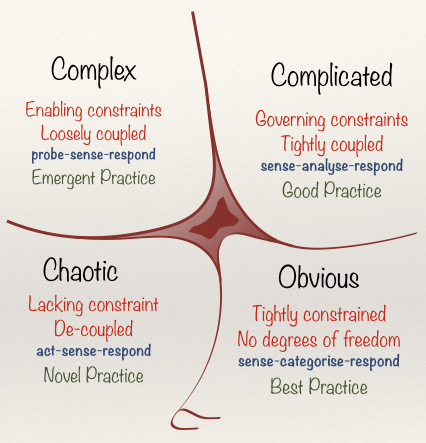AGILE IS NOT THE ANSWER TO EVERYTHING!
May 26, 2016
 A tool is a tool, it fits within a certain domain. I do not use a ladle to get my nails into wood and I do not stir my soup with a hammer (both might work to a certain degree, but are not specifically fit for it).
A tool is a tool, it fits within a certain domain. I do not use a ladle to get my nails into wood and I do not stir my soup with a hammer (both might work to a certain degree, but are not specifically fit for it).
During the trainings I provide for colleagues and clients I often get the question “Where does Agile not work”. Funnily enough the question always focusses on the negative, as if the person who asks wants to disqualify Agile. I would love to one day be asked the opposite, but many people still struggle to get into the Agile mindset and might be looking for things to justify not getting there.
As I said, Agile is seen as a mindset, a way of working. It is not so much a tool, as it is an approach to solving things. So where does Agile work and what is not it’s domain?
more–>
If I need to answer this question I look for examples, situations, I look into my past experiences to see if I can make someone understand.
Until Cynefin..
Cynefin is a framework that Dave Snowden uses to explain the types of systems he identifies. It is also called the sense making model and it has helped me to explain to people where Agile fits.
Within Cynefin Mr. Snowden described four types of systems.
- Obvious
- Complicated
- Complex
- Chaotic
In Obvious systems there is a clear relationship between cause and effect. These things are normal to us. They are obvious and after childhood these things stop to amaze us.
To achieve things within obvious systems we can suffice with a checklist for the actions we take to achieve an obvious goal. Often a checklist is not even necessary as we know what will happen.
Complicated systems usually mean we cannot immediately see the effect of our actions. We need to do some analysis to determine what will happen. it could also mean we need to have acquired some form of expertise to know what will occur and we will therefore need to involve other people.
For these systems we can find Project Management to be necessary. We can set up projects with a clear end and afterwards we will have achieved a goal that we have set in the beginning. Waterfall fits well here.
Complex systems describe the environment where we do not really know the effect until we have experienced a bit of the solution. We need to allow knowledge to emerge while we work on finding out what will work best. Waterfall does not support these systems. We cannot predict what the precise result will be. (I am not referring to Dr. Winston W. Royce’s white paper when I mention Waterfall. It’s the single direction method that emerged later that does not support Complex systems).
Agile frameworks and methodologies require emergent requirements to get the best results. As the Agile principles describe: “Agile processes harness change for the customer’s competitive advantage.”
Chaotic systems have no correlation between cause and effect whatsoever. You need to figure our then and there what the best thing is that you can do, yet there is no guarantee that it is the right thing to do. There are no clear ways to deal with these systems so it is good to monitor the situation continuously and to find novel ways in dealing with what happens.
Now, to answer the question I asked before I started telling you about Cynefin. Where does Agile work? The domain is clear. Agile fits best in the Complex system domain.
Can we use Agile in the complicated systems domain? (Can we use a hammer to stir soup?). Sure we can, Agile will work. It even works in the Obvious systems domain. The question is if it is necessary.
A checklist won’t work in a Complex system, so the ways to deal with the systems will work in the previous systems but not the other way around (as shown in the picture it works clockwise, not counterclockwise).
When I get to a new situation I often look at what kind of system I can determine I am in.
Does Agile work everywhere?
No, and specifically not within Chaotic systems. It works better there than waterfall though.
Within a chaotic system we need to have practices what we can to make it possible to understand the situation we are in. The more muscle memory we have the better we will survive.
I hope Cynefin will make sense to you. It helps me a lot!
find out more on Dave Snowden and Cynefin on: http://cognitive-edge.com/

 English | EN
English | EN 